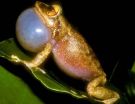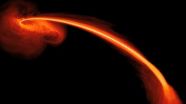(Press-News.org) WEST LAFAYETTE, Ind. - High levels of the greenhouse gas methane were found above shale gas wells at a production point not thought to be an important emissions source, according to a study jointly led by Purdue and Cornell universities. The findings could have implications for the evaluation of the environmental impacts from natural gas production.
The study, which is one of only a few to use a so-called "top down" approach that measures methane gas levels in the air above wells, identified seven individual well pads with high emission levels and established their stage in the shale-gas development process.
The high-emitting wells made up less than 1 percent of the total number of wells in the area and were all found to be in the drilling stage, a preproduction stage not previously associated with significant emissions.
"These findings present a possible weakness in the current methods to inventory methane emissions and the top-down approach clearly represents an important complementary method that could be added to better define the impacts of shale gas development," said Paul Shepson, a professor of chemistry and earth atmospheric and planetary sciences at Purdue who co-led the study with Jed Sparks, a professor of ecology and evolutionary biology at Cornell. "This small fraction of the total number of wells was contributing a much larger large portion of the total emissions in the area, and the emissions for this stage were not represented in the current inventories."
The researchers flew above the Marcellus shale formation in southwestern Pennsylvania in the Purdue Airborne Laboratory for Atmospheric Research, a specially equipped airplane. The aircraft-based approach allowed researchers to identify plumes of methane gas from single well pads, groups of well pads and larger regional scales and to examine the production state of the wells.
"It is particularly noteworthy that large emissions were measured for wells in the drilling phase, in some cases 100 to 1,000 times greater than the inventory estimates," Shepson said. "This indicates that there are processes occurring - e.g. emissions from coal seams during the drilling process - that are not captured in the inventory development process. This is another example pointing to the idea that a large fraction of the total emissions is coming from a small fraction of shale gas production components that are in an anomalous condition."
The bottom-up inventories have been produced from industry measurements of emissions from individual production, transmission and distribution components and then scaling up to create an estimate of emissions for the region. However, with thousands of wells, and a complex processing and transmission system associated with each shale basin, obtaining a representative data set is difficult, he said.
A paper detailing the results will be published in the Proceedings of the National Academy of Sciences on Monday (April 14). The David R. Atkinson Center for a Sustainable Future at Cornell University funded this research.
"We need to develop a way to objectively measure emissions from shale gas development that includes the full range of operator types, equipment states and engineering approaches," Shepson said. "A whole-systems approach to measurement is needed to understand exactly what is occurring."
INFORMATION:
Writer: Elizabeth K. Gardner, 765-494-2081, ekgardner@purdue.edu
Source: Paul Shepson, 765-494-7441, pshepson@purdue.edu
PHOTO CAPTION:
A well pad in southwestern Pennsylvania. A Purdue and Cornell study found high levels of the greenhouse gas methane above shale gas wells during the drilling stage - a production point not thought to be a significant emissions source. (Photo courtesy of Dana Caulton)
A publication-quality photo is available at http://www.purdue.edu/uns/images/2014/shepson-wellpad.jpg
PHOTO CAPTION:
Researchers used the Purdue Airborne Laboratory for Atmospheric Research, a specially equipped airplane, to measure plumes of methane gas above shale gas wells in southwestern Pennsylvania. (Photo courtesy of Paul Shepson)
A publication-quality photo is available at http://www.purdue.edu/uns/images/2014/shepson-plane.jpg
ABSTRACT
Toward a Better Understanding and Quantification of Methane Emissions from Shale Gas Development
Dana R. Caulton, Paul Shepson, Renee L. Santoro, Jed P. Sparks, Robert W. Howarth, Anthony R. Ingraffea, Maria O. L. Cambaliza, Colm Sweeney, Anna Karion, Kenneth J. Davis, Brian H. Stirm, Stephen A. Montzka, and Ben R. Miller
The identification and quantification of methane emissions from natural gas production has become increasingly important owing to the increase in the natural gas component of the energy sector. An instrumented aircraft platform was used to identify large sources of methane and quantify emission rates in southwestern PA in June 2012. A large regional flux, 2.0-14g CH4 s-1 km-2, was quantified for a ~2,800-km2 area, which did not differ statistically form a bottom-up inventory, 2.3-4.6 g CH4 s-1 km-2. Large emissions averaging 34 g CH4s-1 per well were observed from seven well pads determined to be in the drilling phase, 2 to 3 orders of magnitude greater than US Environmental Protection Agency estimates for this operational phase. The emissions from these well pads, representing ~1% of the total number of wells, account for 4-30% of the observed regional flux. More work is needed to determine all of the sources of methane emissions from natural gas production, to ascertain why these emissions occur and to evaluate their climate and atmospheric chemistry impacts.
'Problem wells' source of greenhouse gas at unexpected stage of natural gas production
2014-04-14
ELSE PRESS RELEASES FROM THIS DATE:
Penicillin redux: Rearming proven warriors for the 21st century
2014-04-14
Penicillin, one of the scientific marvels of the 20th century, is currently losing a lot of battles it once won against bacterial infections. But scientists at the University of South Carolina have just reported a new approach to restoring its combat effectiveness, even against so-called "superbugs."
Bacteria have been chipping away at the power of the penicillin family of drugs since their first wide-scale use as antibiotics in the 1940s. For example, the staph infection, brought about by the bacterium Staphylococcus aureus, was once readily treated with penicillin and ...
Study links severe sleep apnea to increased risk of stroke, cancer and death
2014-04-14
DARIEN, IL – A new study shows that moderate to severe obstructive sleep apnea is independently associated with an increased risk of stroke, cancer and death.
Results of the 20-year follow-up study show that people with moderate to severe obstructive sleep apnea were four times more likely to die (hazard ratio = 4.2), nearly four times more likely to have a stroke (HR = 3.7), three times more likely to die from cancer (HR = 3.4), and 2.5 times more likely to develop cancer. Results were adjusted for potential confounding factors such as body mass index, smoking status, ...
Shared decision making during radiation therapy improves patient satisfaction
2014-04-14
PHILADELPHIA—Playing an active role in their radiation treatment decisions leaves cancer patients feeling more satisfied with their care, and may even relieve psychological distress around the experience, researchers from the Perelman School of Medicine at the University of Pennsylvania report in the journal Cancer.
In a study of 305 patients undergoing radiation treatment, Neha Vapiwala, MD, an associate professor in the department in Radiation Oncology at Penn Medicine, and colleagues at link "Penn's...Center: Penn's Abramson Cancer Center found an association between ...
Plague alters cell death to kill host
2014-04-14
Northwestern Medicine scientists are continuing to unravel the molecular changes that underlie one of the world's deadliest and most infamous respiratory infections.
When the bacterium Yersinia pestis enters the lungs, it causes pneumonic plague, a disease that is 100 percent fatal if untreated. The way in which Y. pestis evades the immune system and kills people in a matter of days has largely confounded scientists, until now.
Following a 2007 study demonstrating that the presence of a protein called the plasminogen activator protease (Pla) is required for Y. pestis ...
Climate change a likely culprit in coqui frog's altered calls, say UCLA biologists
2014-04-14
Changes in the Puerto Rican climate over the past three decades have caused small but significant changes to the coqui frog, the territory's national animal. UCLA biologists have found that not only have male coquis become smaller, but their mating call has also become shorter and higher pitched.
Authored by Peter Narins, UCLA distinguished professor of integrative biology and physiology and of ecology and evolutionary biology, and Sebastiaan Meenderink, a UCLA physics researcher, the study examined 170 male coqui frogs (Eleutherodactylus coqui) in 1983 and then 116 ...
Making dams safer for fish around the world
2014-04-14
RICHLAND, Wash. – Think of the pressure change you feel when an elevator zips you up multiple floors in a tall building. Imagine how you'd feel if that elevator carried you all the way up to the top of Mt. Everest – in the blink of an eye.
That's similar to what many fish experience when they travel through the turbulent waters near a dam. For some, the change in pressure is simply too big, too fast, and they die or are seriously injured.
In an article in the March issue of the journal Fisheries, ecologists from the Department of Energy's Pacific Northwest National ...
Cosmic slurp
2014-04-14
Somewhere in the cosmos an ordinary galaxy spins, seemingly at slumber. Then all of a sudden, WHAM! A flash of light explodes from the galaxy's center. A star orbiting too close to the event horizon of the galaxy's central supermassive black hole is torn apart by the force of gravity, heating up its gas and sending out a beacon to the far reaches of the universe.
In a universe with tens of billions of galaxies, how would we see it? What would such a beacon look like? How would we distinguish it from other bright, monumental intergalactic events, like supernovas?
"Black ...
Researchers identify children with emotional behavior difficulties
2014-04-14
Research on children orphaned by HIV/AIDS in South Africa may provide insight on how to identify and help children with emotional behavior issues in other areas of the world, which may have limited access to healthcare and further research that could lead to successful interventions.
A report on the global AIDS epidemic published by the United Nations mentions that due to the HIV/AIDS pandemic, which has left 12 million children orphaned in Sub-Saharan African, children are at an increased risk for mental health problems.
"There has been a big push to understand what ...
Henry Ford Hospital hits new heart valve surgery milestone
2014-04-14
DETROIT – Doctors at Henry Ford Hospital reached a medical milestone April 3, performing the 25th successful transcatheter valve replacement using a novel way to access the heart.
Henry Ford is the only hospital in the United States performing the unique procedure called transcaval valve replacement, which accesses the heart by temporarily connecting major blood vessels.
Northern Michigan resident Viola Waller, 80, underwent Henry Ford's first transcaval procedure on July 3, 2013 when traditional valve replacement was not medically viable.
"Nobody could help me here," ...
Dog ownership benefits families of children with autism, MU researcher finds
2014-04-14
COLUMBIA, Mo. –Many families face the decision of whether to get a dog. For families of children with autism, the decision can be even more challenging. Now, a University of Missouri researcher has studied dog ownership decisions in families of children with autism and found, regardless of whether they owned dogs, the parents reported the benefits of dog ownership included companionship, stress relief and opportunities for their children to learn responsibility.
"Children with autism spectrum disorders often struggle with interacting with others, which can make it difficult ...








